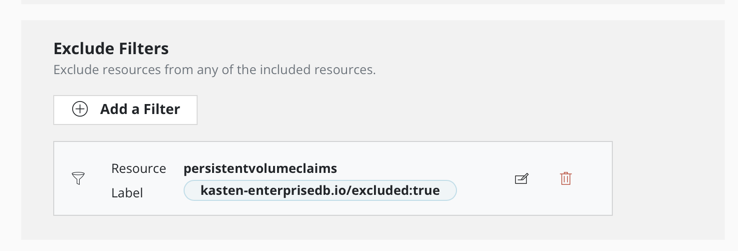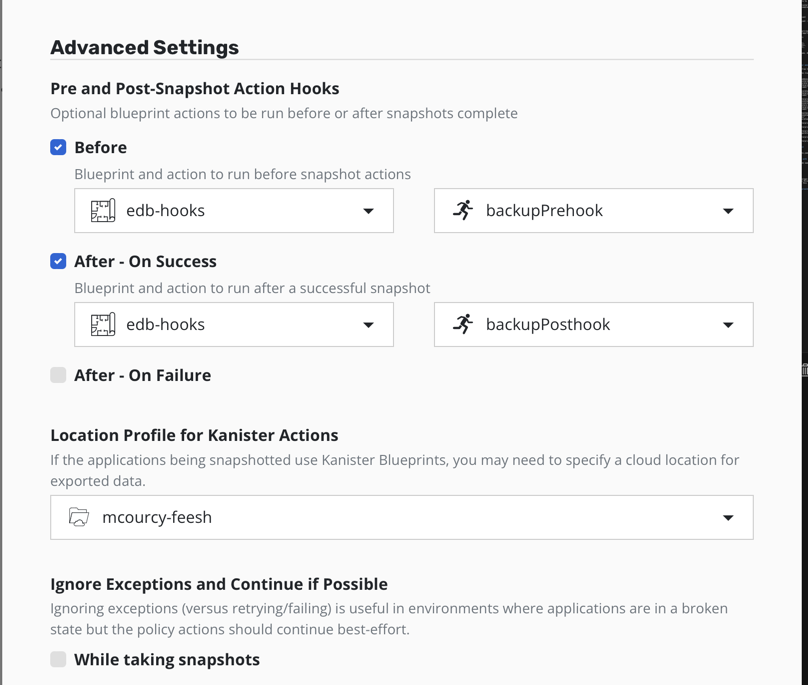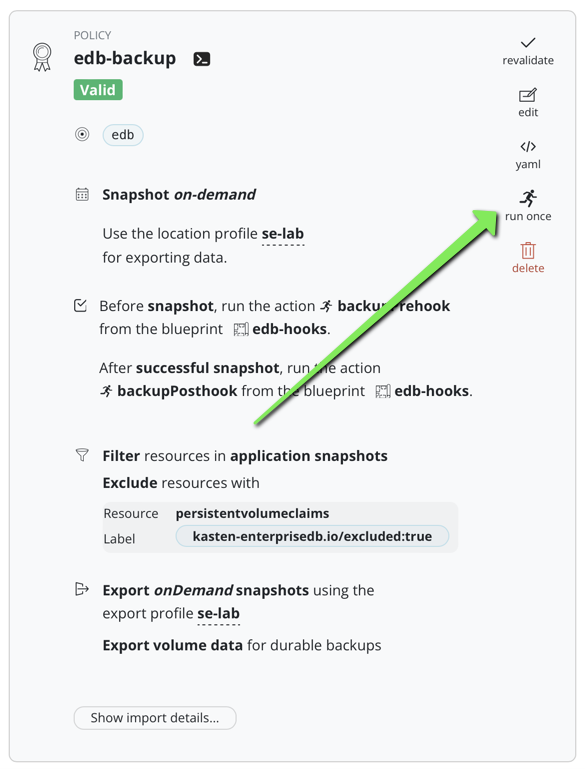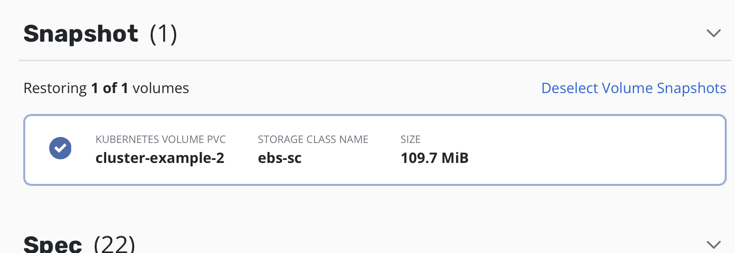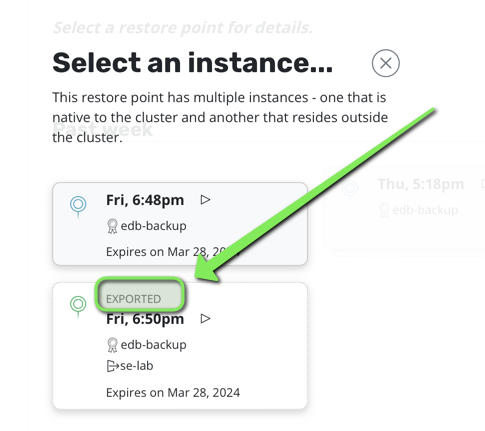The goal of this project is to show how Kasten can be used with the EDB external backup adapter to create fast and consistent backup for EDB cluster.
The external backup adapter create through annotations or labels a way for third party tool as Kasten to discover the api that they have to invoke to take a safe storage backup.
This approach take full advantage of the Kasten data management for backing up pvc (snapshot are fully incremental and portable) and using EDB API to take consistent backup of large clusters.
- The EDB Backup adapter will put the annotations/labels on one of the replicas (not the primary) that has the commands to switch on backup mode (in EDB terms to be
fenced) - Kasten prebackup hook blueprint discover this replica and call the EDB pre-backup command on it, now the replica is
fencedand its PVC is fully consistent for a backup - Kasten proceed the backup of the complete namespace as usual but we configure the policy to exclude the PVC having the label
kasten-enterprisedb.io/excluded: "true", only the PVC of thefencedreplica will be captured, the other's PVC instance will be exluded of the backup. - Kasten postbackup hook blueprint call the EDB post-backup commands, the elected replica is
unfencedand back in a "normal" mode - When Kasten restore the namespace, the EDB operator discover the pvc of the
fencedreplica and use it as the primary for the EDB cluster, it recreates the other replica instances from it.
If you already have EDB operator installed on kubernetes you can skip this part
kubectl apply -f https://get.enterprisedb.io/cnp/postgresql-operator-1.20.2.yaml
This will create the operator namespace where the controller will be running.
kubectl create ns edb
kubectl apply -f cluster-example-2.yaml -n edb
Wait for the cluster to be fully ready.
kubectl get clusters.postgresql.k8s.enterprisedb.io -n edb
NAME AGE INSTANCES READY STATUS PRIMARY
cluster-example 19m 3 3 Cluster in healthy state cluster-example-1
Install the cnp plugin if you haven't it yet
curl -sSfL \
https://github.com/EnterpriseDB/kubectl-cnp/raw/main/install.sh | \
sudo sh -s -- -b /usr/local/bin
Create a client certificate to the database
kubectl cnp certificate cluster-app \
--cnp-cluster cluster-example \
--cnp-user app \
-n edb
Now you can create the client
kubectl create -f client.yaml -n edb
Create some data
kubectl exec -it deploy/cert-test -- bash
psql " $DATABASE_URL "
\c app
DROP TABLE IF EXISTS links;
CREATE TABLE links (
id SERIAL PRIMARY KEY,
url VARCHAR(255) NOT NULL,
name VARCHAR(255) NOT NULL,
description VARCHAR (255),
last_update DATE
);
INSERT INTO links (url, name, description, last_update) VALUES('https://kasten.io','Kasten','Backup on kubernetes',NOW());
select * from links;
\q
exit
You can skip this part if you create the cluter from the previous section because with cluster-example-2 the cluster-example already include the kasten addon.
If you have not it yet just had this annotation in your cluster CR
"k8s.enterprisedb.io/addons": '["kasten"]'
If your version of EDB is old and does not support the kasten addons you can create all the annotations and labels manually you have an example in cluster-example.yaml .
kubectl create -f edb-hooks.yaml
Create a Kasten policy for the edb namespace: set up a location profile for export and kanister actions.
kasten-enterprisedb.io/excluded:true
Launch a backup, that will create 2 restorepoints a local and a remote.
When you'll visit the restore point you'll see that only one PVC has been taken then one that map to
the fenced instance.
Delete the namespace edb
kubectl delete ns edb
Because you deleted the namespace all the volumesnaphot are gone hence you need to restore from the external location profile.
Just click restore and wait for the EDB cluster to restart.
You should see pod cluster-example-2 immediatly starting (without initialization of the database) and the cluster-example-3 and cluster-example-4 joining.
kubectl get po -n edb -w
NAME READY STATUS RESTARTS AGE
cert-test-5dcf5cb6b8-fhf4m 1/1 Running 0 3s
cluster-example-2 0/1 Init:0/1 0 1s
cluster-example-2 0/1 PodInitializing 0 3s
cluster-example-2 0/1 Running 0 4s
cluster-example-2 1/1 Running 0 5s
cluster-example-2 1/1 Running 0 5s
cluster-example-3-join-vm6d9 0/1 Pending 0 0s
cluster-example-3-join-vm6d9 0/1 Pending 0 5s
cluster-example-3-join-vm6d9 0/1 Init:0/1 0 5s
cluster-example-3-join-vm6d9 0/1 PodInitializing 0 10s
cluster-example-3-join-vm6d9 1/1 Running 0 11s
cluster-example-3-join-vm6d9 0/1 Completed 0 13s
cluster-example-3-join-vm6d9 0/1 Completed 0 15s
cluster-example-3-join-vm6d9 0/1 Completed 0 16s
cluster-example-3 0/1 Pending 0 0s
cluster-example-3 0/1 Pending 0 0s
cluster-example-3 0/1 Init:0/1 0 0s
cluster-example-3 0/1 PodInitializing 0 4s
cluster-example-3 0/1 Running 0 5s
cluster-example-3 0/1 Running 0 5s
cluster-example-3 1/1 Running 0 6s
cluster-example-4-join-rtpxf 0/1 Pending 0 0s
cluster-example-4-join-rtpxf 0/1 Pending 0 5s
cluster-example-4-join-rtpxf 0/1 Init:0/1 0 5s
cluster-example-4-join-rtpxf 0/1 PodInitializing 0 9s
cluster-example-4-join-rtpxf 0/1 Completed 0 10s
cluster-example-4-join-rtpxf 0/1 Completed 0 12s
cluster-example-4-join-rtpxf 0/1 Completed 0 13s
cluster-example-4 0/1 Pending 0 0s
cluster-example-4 0/1 Pending 0 0s
cluster-example-4 0/1 Init:0/1 0 0s
cluster-example-4 0/1 PodInitializing 0 6s
cluster-example-4 0/1 Running 0 7s
cluster-example-4 0/1 Running 0 7s
cluster-example-4 1/1 Running 0 8s
cluster-example-4-join-rtpxf 0/1 Terminating 0 21s
cluster-example-3-join-vm6d9 0/1 Terminating 0 43s
cluster-example-4-join-rtpxf 0/1 Terminating 0 21s
cluster-example-3-join-vm6d9 0/1 Terminating 0 43s
cluster-example-3 1/1 Running 0 28s
cluster-example-2 1/1 Running 0 50s
cluster-example-4 1/1 Running 0 9s
As you restore everything you also restore the client, connect to the client and check you have your data.
kubectl exec -it deploy/cert-test -- bash
psql " $DATABASE_URL "
\c app
select * from links;
\q
exit
You should see your data back
app=> select * from links;
id | url | name | description | last_update
----+-------------------+--------+----------------------+-------------
1 | https://kasten.io | Kasten | Backup on kubernetes | 2024-03-25
